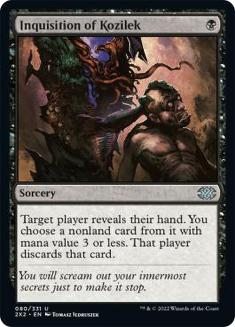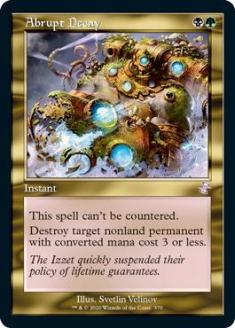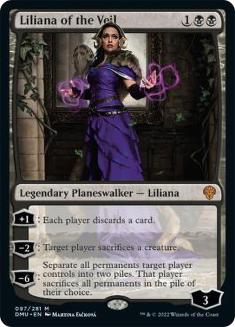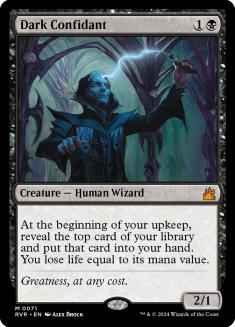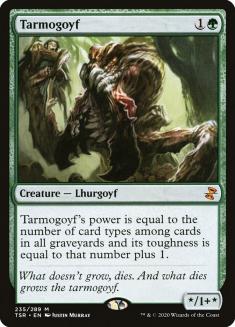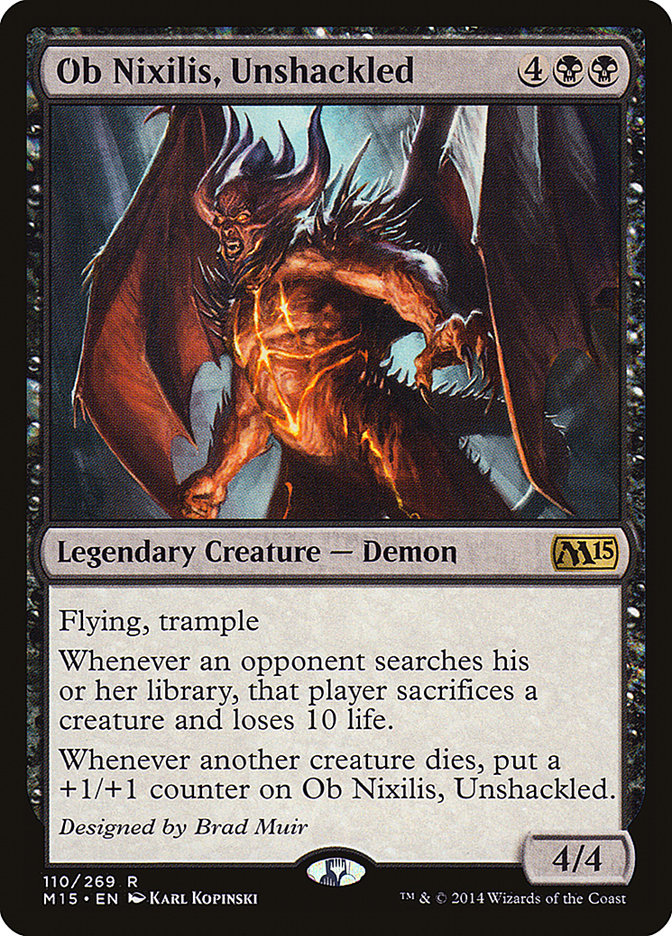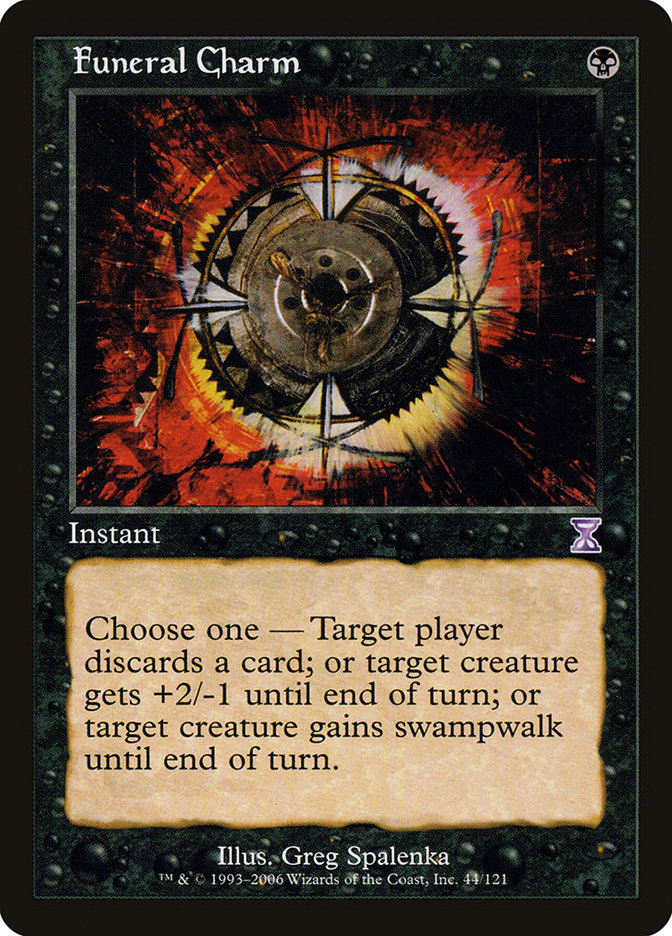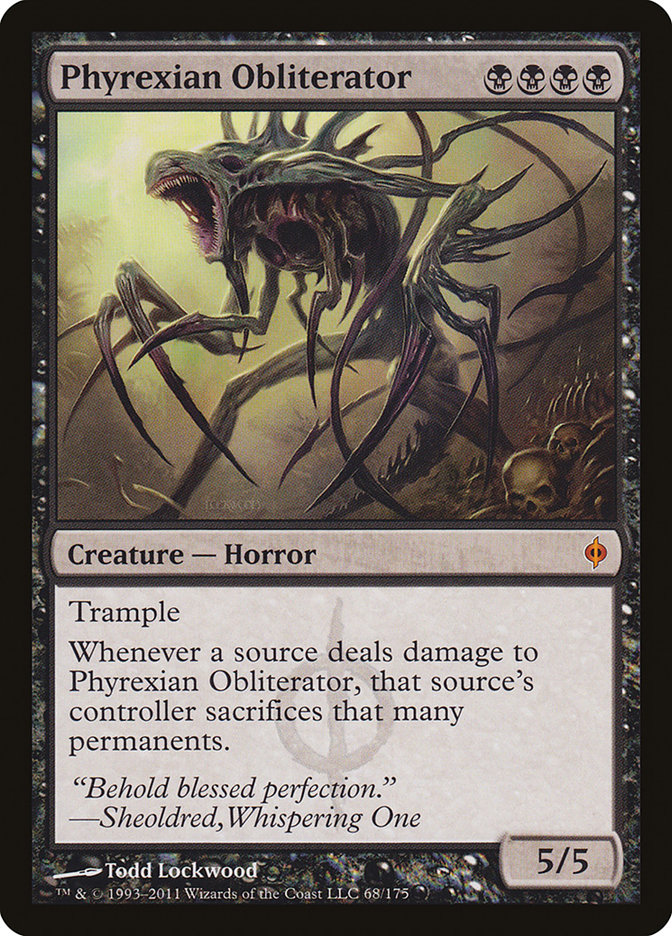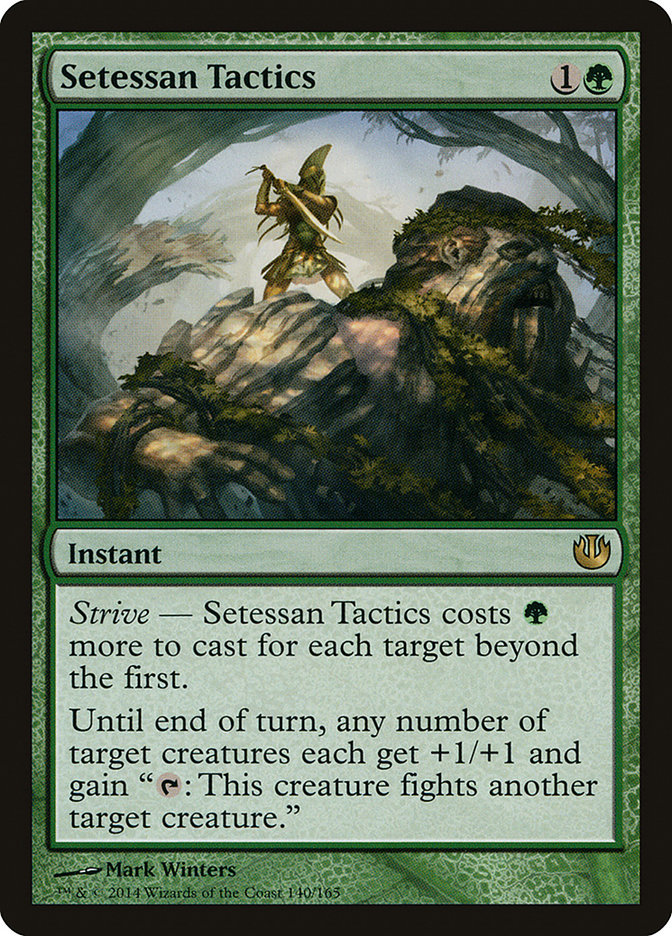As far as Modern goes, the lead up to Boston has been a quiet affair. There have been some bits and dribbles of information, but if you are trying
to get a sense of what is happening with the format since Grand Prix Minneapolis in May, you’d be hard-pressed to find anything of use.
As the Modern season began, I wrote about what a player
could expect from it, going through 320 prominent decks in an attempt to find an answer. As for myself, I packed up my car and three Modern decks
(and a lot of extra cards) for a weekend trip: a double-PTQ with a drive to Ohio, followed by a trip back to either Fort Wayne, IN or Chicago. The plan:
get out there and win the Ohio PTQ, but if that “plan” fell through, come back and hit one of the other PTQs, depending on how late I was out of contention
in Ohio.
Of course, not all plans come to fruition, and this was how my trip began
before I even got out of Madison:

Some people very kindly offered to take me to the Sunday PTQ, but I was in no shape. There was a lot to be done, and a PTQ didn’t seem like the right call.
In the time since, I dodged the need to completely dive into Modern by my third place performance in Chicago. That being said, I have this problem where
I’m always working on any and all tournament formats, and that includes Modern. I was talking with one of my favorite players on the SCG circuit, Jeff
Hoogland, about Modern, and he asked if I had any sweet Modern lists. I had a good laugh at the conversation, which went roughly like this when I sent him
one of my lists:
Jeff: Oh, gosh! Wasn’t expecting that type of list out of you!
Me: Why? Are you trying to pigeonhole me, Jeff? 🙂
Jeff: Yes. Yes, I am. I would have expected something U/x – something controlling. Or Burn.
Me: Well, here are the Modern decks I’m still currently working on: Seismic Loam, BUG Infect, UW-Midrange Control, BluManji, The Rock, Naya Burn, Merfolk,
Cruel Control, Curious George, Grixis Delver, W/x Prison, RUG Baron, Tree-Aggro, Turbo Fog, and the so-called “Sullivan Special.”
Jeff: Ha ha ha. Okay.
I work on everything that I can that makes sense to me. At least anything that I enjoy playing. I’m not sure what it is, but I’ve found myself not really
enjoying Splinter Twin lists or Affinity. Pod has a little bit of appeal, but I just didn’t enjoy it as much as I enjoyed playing BluManji, and I didn’t
enjoy it enough on its own to not just want to play another strong deck. My choice to play Grixis Delver may have been disastrous at GP Minneapolis, but it
was based on a mistaken belief that I could afford to be a little weaker against Affinity and be fine.
Oops.
One of the most important lessons I learned in writing
“320 Modern Decks. 4 Lessons.” was just how big a deal being good against aggressive decks was in Modern.
Since then, I’ve collected all of the PTQ information that I can about Modern. This is partly gleaned from individual stores, partly from Wizards of the
Coast, partly from on-the-scene friends who I trust.
So, here it is, the results of the eighteen PTQs I was able to get data from with each place listed out individually:
The Rock/Jund/Junk: 1111122223333445555577888
Pod (Kiki): 156
Pod (Melira): 111246677
Pod (Angel): 22
Scapeshift: 11123457
Twin (Splinter): 11223446667
Twin (Faeries): 8
Twin (Tarmo): 3455
Twin (UWR): 6
Faeries: 11334
Affinity: 123344456667777777888
UWR (Kiki Control): 18
UWR (Midrange Control): 23345668
GW Hatebears: 2245566
Burn: 23456688
Tron (all varieties): 23445
Bogles: 234
Merfolk: 3677
Zoo: 3
Elves: 4
Ad Nauseum: 5677
UR Delver: 588
Pyromancer’s Ascension: 888
TurboMill: 6
Amulet: 7
BW Tokens: 8
This is a bit different than the results from early
June.
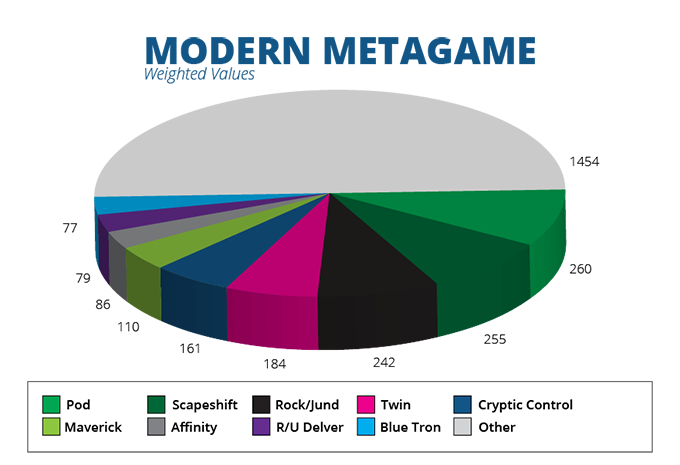
In that moment in time, the metagame was wildly more diverse than it appears to be moving now. Previously, easily half of the metagame was composed of
“other” decks. Now, that number is actually down below less than ten percent of the top decks.
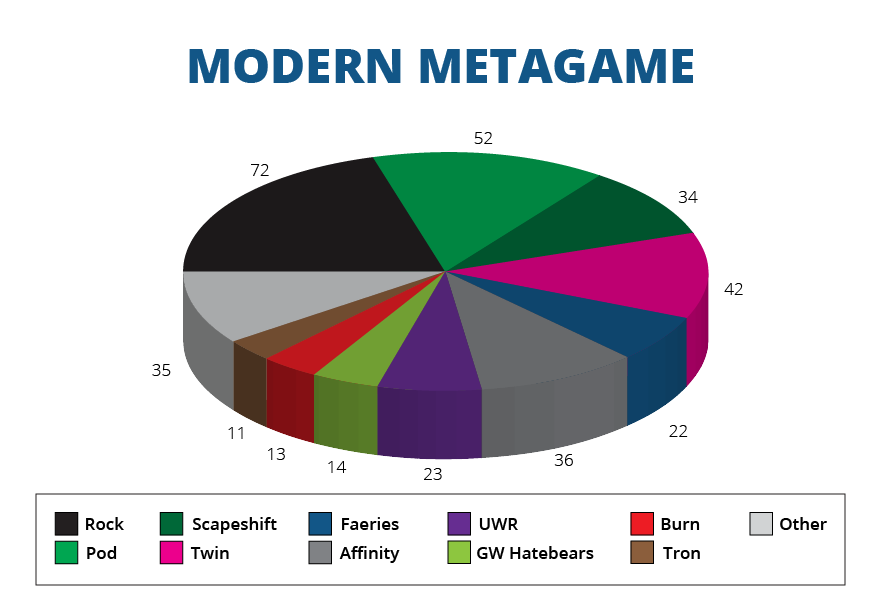
One of the things that has been largely happening for a great many people in this current metagame is a struggle for information that rivals the pre-Dojo
days of the mid-nineties. If you’re like me, you’re always on the hunt for data about what is happening in the game. Lately, for a large number of
reasons, getting that information about the Modern metagame has been exceedingly difficult.
Perhaps this is why we see such a huge influx of Rock-style decks. While there certainly were a few Jund lists and an odd Junk list, almost all of the
decks in the “Rock” category above are the pure Black/Green Midrange decks we’ve all come to know and love. If you look at this combination of cards:
These cards are all basically saying, “Let’s make sure you don’t have fun!” There aren’t any counterspells in this mix, but there certainly are a lot of
“no”, combined with very powerful pressure from either the dude factor (power/toughness) of Tarmogoyf versus the card economy factor of Bob (Dark
Confidant).
Out of eighteen PTQs, there are a total of twenty-five of these decks in the Top 8, and that doesn’t feel surprising to me. The next most commonly
appearing lists are varieties of Birthing Pod lists, and they only appear fourteen times.
I don’t think that the “Rock on top” phenomena is going to last. I love The Rock, and one of the decks that I’ve been strongly considering is my own
version of The Rock with Phyrexian Obliterators. I just think The Rock is likely to fall out of favor because it has started to so obviously be a
deck worth targeting that it will start getting the brunt of the format falling onto it.
Imagine, for example, you are prepping for your next PTQ, and at the three PTQs that you attended, the only deck that was in the Top 8 of all three PTQs
was The Rock, and it won one of those PTQs. What is the first deck you’re going to test against? Expect every serious PTQer to do the same.
One of my favorite builds of The Rock (other than my own, of course *wink*) comes from Chapman Sim, who won a PTQ in the huge Indonesian city of Surabaya
(over three million people!) with the deck. His list is straightforward and powerful and doesn’t really get bogged down in trying to do anything tricky.
Creatures (14)
Planeswalkers (4)
Lands (25)
Spells (17)

If you’re looking for something straightforward, I think this is The Rock list for you. Let’s not worry about getting fancy, Chapman says. Instead, let’s
just make sure we have enough of all of the tools to fight against whatever we need to fight against.
I think the only thing I’m not excited about are the three Fulminator Mages. I completely understand that Tron decks exist, that Fulminator Mage can kill a
Celestial Colonnade or an Inkmoth Nexus, and that it can be used against Scapeshift. I guess I just don’t much care. I understand the value of the card – I
just don’t know that it makes me feel like it is worth it.
Pod’s successes aren’t a big surprise for anyone that has been paying attention. Take this sample list from Seoul, South Korea:
Creatures (28)
- 4 Birds of Paradise
- 1 Eternal Witness
- 1 Wall of Roots
- 1 Orzhov Pontiff
- 1 Shriekmaw
- 1 Reveillark
- 4 Kitchen Finks
- 1 Murderous Redcap
- 1 Ranger of Eos
- 3 Noble Hierarch
- 1 Qasali Pridemage
- 1 Linvala, Keeper of Silence
- 1 Viscera Seer
- 1 Thrun, the Last Troll
- 1 Spellskite
- 1 Melira, Sylvok Outcast
- 1 Scavenging Ooze
- 3 Voice of Resurgence
Lands (23)
Spells (9)

There’s a part of me that is a bit surprised that I’m not more into this archetype. In so many ways, this deck is just a variant on the classic
Recurring-Survival deck, and I played that deck at the 2000 Masters Series. While I should have played Stasis (the deck I gave Tony Dobson and Gary Wise),
this entire style of deck is one I’ve generally loved in the past. I think that I might be a little anti-Pod mostly because I’ve had a lot of success
beating other people playing the deck with archetypes that are “supposed” to lose to this deck; whenever that happens, I tend to be a little suspicious.
Value, value, value. That’s what this deck tries to do, consistently playing out cards that will grab a little more advantage until you either just win,
well, because, or you assemble the Melira combo (or, in other versions, the Archangel combo, or the Kiki combo) and they die on the spot.
I do think it is noteworthy that of the fourteen Pod lists I looked at, three of them were won by the Melira-style builds, as compared to only one
Kiki-style (and none that were purely Archangel builds). While I’m a little enamored of the Archangel-only builds, they aren’t winning as much – perhaps
because less people are playing them, or perhaps simply because the Melira builds are “better”.
I do find myself wondering if the “nonbo” of Hushwing Griffin with the deck will end up finding its way into this deck’s sideboard. My feeling is that if
you’re looking for another effect that might be useful in this way, a second Linvala, Keeper of Silence will be the card you’ll use, but more than one
player I’ve talked to mentioned it as a card they are considering. I’m sure this bad boy is just too slow, but I like imagining this hitting play:
BOOM!
Scapeshift is the only other deck that ended up winning three different PTQs. For the most part, this deck isn’t really seeing all that much variance from
the excellent build by Jun Young Park that won Grand Prix Minneapolis.
This version, by Simone Lampasona, won a PTQ with almost 300 competitors in Italy. It opted for a slightly more controlling feel, putting one of Modern’s
best cards into the mix – Lightning Bolt
Here is his list:
Creatures (6)
Lands (25)
Spells (29)

While Simone’s deck doesn’t include Batterskull in the board, it still feels like he is going for a much more controlling feel to the deck. Lightning Bolt can help accomplish the last portion of a kill, but you only need Bolt to help with a kill if, (a) your Scapeshift was only going to deal
eighteen, and, (b) your opponent didn’t help you out by hurting themselves in some way. No, in his deck, Lightning Bolt is here to help hold down
the fort , to keep the game going a few turns longer so that you can assemble enough lands to make a resolved Scapeshift lethal.
After board, Teferi, Mage of Zhalfir looks positively frightening for anyone hoping to fight a counterspell war. Aside from Teferi being an incredible way
to protect your own combo, I pity the poor Splinter Twin player who isn’t ready to win yet and is suddenly faced with Teferi on the stack. Dispel, whut?
This more controlling approach makes a lot of sense to me, mostly because I think that you need to respect the fact that your opponents aren’t just going
to let you do what you want to do, at least for the most part. Even Affinity has a lot of ability to interact with any deck’s plan after game 1, and so
making a choice to slow down a touch makes sense to me. We’re used to seeing Lightning Bolt in Twin lists, so it doesn’t surprise me that it could be a
good choice for the main. To me, the closest analog to Scapeshift in Modern is the 1999-era High Tide decks which were basically control decks, at least
until that moment they won.
None of the other decks of the eighteen PTQs I looked at were able to secure as many slots as these three decks. Affinity was clearly the most successful
aggressive deck, with 21 decks in various Top 8s, but it seems like it has a real “closing” problem; not only was it only able to get one player an
invitation, but at least five players making the finals would be reasonable with that many players, yet only two did.
Modern still seems to be a format about playing something good that is structurally sound, but it also strongly rewards just knowing what you’re
supposed to be doing in every moment. While the format may be less diverse-feeling than it once was, it is still pretty wildly diverse, particularly when
you break things out to subgenres (the difference between Tarmo-Twin and normal Splinter Twin, for example).
In this format, I still feel pretty good about just being the boring person who says no to everyone else’s party. Here is my current version of The Rock:
Creatures (16)
Planeswalkers (3)
Lands (24)
Spells (17)

I’ve been working on this deck for a long time, but I’m
still really happy with it. I’m trying to figure out if I want some number of Drown in Sorrow.
A lot of people get a little shocked about this little card:
After a lot of testing over several years, I love the card a lot. It isn’t Lightning Bolt, but it does a lot of work in so many matchups, killing many
early creatures without the need to lose four life, helping make Liliana empty someone’s hand, or occasionally just “going to the dome” via landwalk or
+2/-1. If you are gun-shy on it, try an extra discard, an extra Liliana, and a Dismember.
The sideboard c-c-c-combo that this deck has access to looks cute. But, wow, is it actually just good:
Sometimes, you just can’t win. In combination with my favorite alien, Phyrexian Obliterator, Tactics can let you win when you shouldn’t have. At other
times, you can just machine-gun down a bunch of dorks. Either way, this is the card Pit Fight wanted to be in this deck when I played around with that card
a long while ago.
Whatever you play at GP Boston or your next PTQ, given the nature of this format, I have one major piece of advice:
Play as many games against as many decks as you can.
Good luck!


